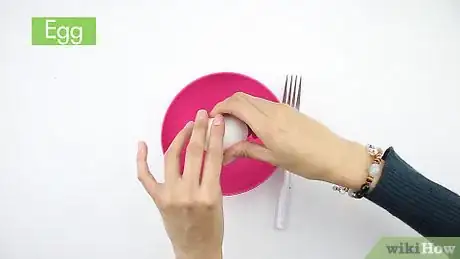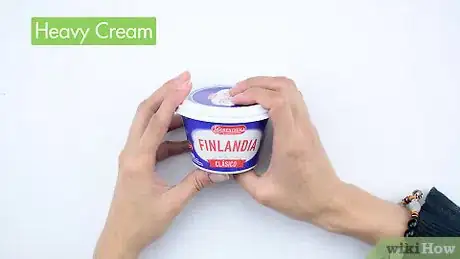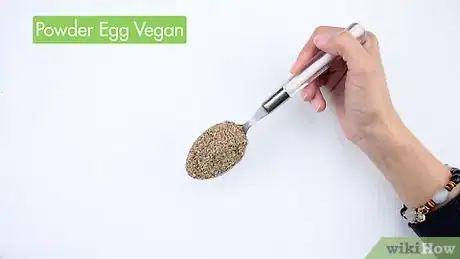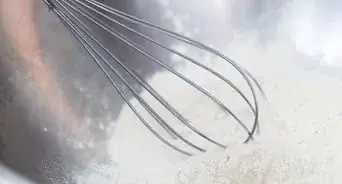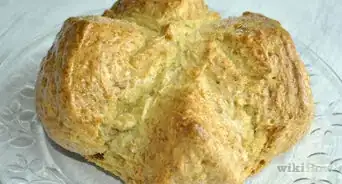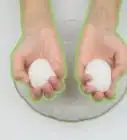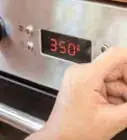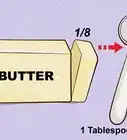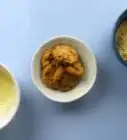This article was co-authored by wikiHow staff writer, Jessica Gibson. Jessica Gibson is a Writer and Editor who's been with wikiHow since 2014. After completing a year of art studies at the Emily Carr University in Vancouver, she graduated from Columbia College with a BA in History. Jessica also completed an MA in History from The University of Oregon in 2013.
wikiHow marks an article as reader-approved once it receives enough positive feedback. This article received 13 testimonials and 84% of readers who voted found it helpful, earning it our reader-approved status.
This article has been viewed 1,259,858 times.
Learn more...
Applying an egg wash is one of the easiest ways to make your baked goods really stand out. For a basic egg wash, whisk 1 whole egg with up to 1 tablespoon (15 ml) of water, cream, or milk. Brush the egg wash over the food just before you bake it or use the egg wash to seal pastry together. If you'd like to use an egg wash substitute, you can use olive oil, egg replacements, or plain milk products. Whatever you choose to use, it's simple to adjust the egg wash so you get great results.
Ingredients
- 1 whole egg
- 1 teaspoon (4.9 ml) to 3 teaspoons (15 ml) milk, heavy cream, or water
Makes enough egg wash for 1 loaf of bread or pie
Steps
Whisking the Egg Wash
-
1Crack the egg into a small bowl. You can use any type of egg and any sized egg. Keep in mind that a jumbo chicken egg will make more egg wash than a small chicken egg or quail egg.
- If you want to make a dark egg wash, use just the yolk and a pinch of salt. The salt will liquefy the yolk so it's easier to spread.
-
2Add 1 teaspoon (4.9 ml) of liquid. You can use water, milk, heavy cream, or soy milk according to your preferences. The liquid thins the egg yolk so it won't dry your pastry out and cause it to crack in the oven. If the egg wash looks too thick, you can thin it out with another 1 teaspoon (4.9 ml) to 2 teaspoons (9.9 ml) of liquid.[1]
- Keep in mind that each liquid will give you a different look. For example, water will give a matte appearance while milk and cream give shine.
Advertisement -
3Whisk the egg wash until it's combined. Hold a whisk or fork and use your wrist to beat the egg and liquid in a circular motion. Whisk the egg wash for up to 10 seconds so the yolk is well blended and mixed with the white.
- Avoid whisking the egg wash until the egg foams.
-
4Whisk in any additional items according to your needs. You can whisk a few pinches of spice such as nutmeg or cinnamon, if you want the egg wash to have a darker color with a hint of flavor. Add a few dashes of salt if you want a shiny surface or stronger binding for pastry.[2]
-
5Thin the egg wash with more liquid, if necessary. If you are glazing something that is going to expand a lot such as puff pastry or bread, mix in another 1 teaspoon (4.9 ml) to 2 teaspoons (9.9 ml) of liquid to prevent cracking as the pastry expands.[3]
Selecting an Egg-Free Alternative
-
1Use plain half-and-half or heavy cream. If you'd like to leave the egg out of the wash, you can still add golden color to your baked goods. Brush half-and-half or heavy cream on your baked goods for a matte finish.[4]
- Keep in mind that the heavy cream is more likely to crack as it expands.
-
2Brush olive oil instead of egg wash. Olive oil is a good vegan substitute for egg wash. Just brush pure olive oil directly on your bread or baked goods. While olive oil will give your baked goods a little shine, it may give a faint olive oil flavor so avoid brushing it on sweet baked goods.[5]
- For another vegan egg wash, mix a few teaspoons of water with soy powder.
-
3Use a commercial egg substitute. Buy a vegan egg replacement or purchase an egg substitute that's made with egg whites and thickeners. If you're using a liquid substitute, brush it directly on the baked goods. If you're using a powder, mix a little water into the powder so it's spreadable.[6]
Using the Egg Wash
-
1Brush the egg wash over your bread. Dip a pastry brush into the egg wash or egg wash alternative. Spread it evenly over the top of the bread, but avoid using so much that the egg wash runs down the sides. This could cause the bread to stick to the pan. Score the bread and bake it as directed.[7]
- If a lot of egg wash puddles near the bottom of the bread, you'll have bits of cooked egg stuck to the loaf.
-
2Spread egg wash over the bottom of an unbaked pie crust. To prevent soggy bottom crusts, brush the egg wash over the unbaked pastry before you add the filling. As the pie cooks, the egg wash will cook and prevent liquids in the filling from soaking into the bottom crust.[8]
-
3Seal the edges of pastry with egg wash. If you're making puff pastry, cooking turnovers, or baking sandwich cookies, brush egg wash along the edges on 1 side of the pastry. Fold or place the top layer over pastry over the washed edges and press down gently. The egg wash will keep the pastry stuck together.[9]
- If you'd like the pastry to be pale and crisp, consider making an egg wash with just the egg white and water.
-
4Cover the top of the baked goods. Once you've filled your pie, assembled your rolls, or made your croissants, brush the tops with egg wash. Bake the items immediately to get the best finish on them. Try brushing an egg wash on top of:
- Bread and rolls
- Pastries and danishes
- Pie
- Meat pies such as pasties, empanadas, and shepherd's pie
- Puff pastry hors d'oeuvres
- Cut-out cookies
-
5Use the egg wash to secure seeds, sugar, or pastry. If you plan on decorating your food, brush it with egg wash and then sprinkle the embellishments on top. The egg wash will hold the decorations in place.[10]
- For example, brush a pie with egg wash and sprinkle coarse sugar on top. If you're baking bread, scatter sesame or poppy seeds over the wash.
- If you want to lay decorative pastry pieces on top of pastry, brush a little egg wash on the decorations before setting them in place.
Community Q&A
-
QuestionWhen do you put egg wash on pies?
 Community AnswerBrush it on just before you pop the pie in the oven. It is the last step before baking - unless you're sprinkling sugar over the top, then do that after the wash.
Community AnswerBrush it on just before you pop the pie in the oven. It is the last step before baking - unless you're sprinkling sugar over the top, then do that after the wash. -
QuestionWhy do I have blotched pastry after doing an egg wash?
 Community AnswerYou either used the wrong additive (heavy cream over water/milk) in your egg wash, or used too little additive and it didn't have enough give. If you used heavy cream, try using milk, and add an extra couple of teaspoons.
Community AnswerYou either used the wrong additive (heavy cream over water/milk) in your egg wash, or used too little additive and it didn't have enough give. If you used heavy cream, try using milk, and add an extra couple of teaspoons. -
QuestionIs it a problem to add the egg wash over a pie before you freeze the pie, to be later thawed and baked?
 Community AnswerGenerally that would not be a great idea because when you freeze the pie, the egg wash will probably go crumbly and kind of disappear. Once you thaw it you should add the egg wash so it's fresh and when the pie is baking, the eggs will cook into it and give it a nice brown color.
Community AnswerGenerally that would not be a great idea because when you freeze the pie, the egg wash will probably go crumbly and kind of disappear. Once you thaw it you should add the egg wash so it's fresh and when the pie is baking, the eggs will cook into it and give it a nice brown color.
Things You'll Need
- Whisk or fork
- Small bowl
- Pastry brush
- Measuring spoons
References
- ↑ http://www.joepastry.com/2013/on-egg-wash/
- ↑ http://www.cooksinfo.com/egg-wash
- ↑ http://www.joepastry.com/2013/on-egg-wash/
- ↑ http://www.cooksinfo.com/egg-wash
- ↑ http://www.cooksinfo.com/egg-wash
- ↑ http://www.cooksinfo.com/egg-wash
- ↑ http://www.finecooking.com/article/put-color-and-shine-on-pastry-crust-with-an-egg-wash
- ↑ http://thepioneerwoman.com/food-and-friends/egg-wash-101/
- ↑ http://thepioneerwoman.com/food-and-friends/egg-wash-101/
About This Article
To make an easy egg wash for cooking and baking, crack an egg into a bowl and add 1 teaspoon of milk, cream, or water to the egg. Whisk the egg and the liquid together with a fork or a whisk for 10 seconds until it is combined completely. You can add spices or seasoning to the egg wash according to your cooking needs. If you need more egg wash for recipes that expand as they bake, like pastries or bread, you can thin the wash with 1 to 2 teaspoons of water. For tips on how to make an egg wash without eggs, read on!
